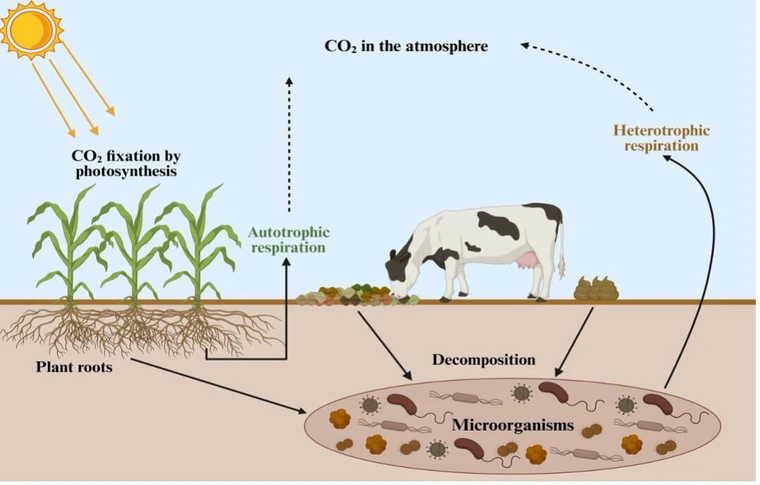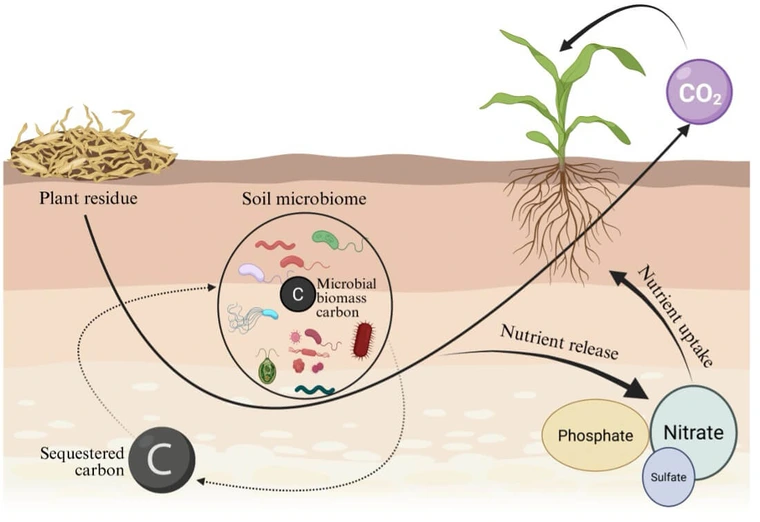Soil respiration is an integral part of the global carbon cycle as carbon dioxide is released from the soil and released into the atmosphere. As living entities in the soil metabolize carbonaceous compounds, they breathe out (release) carbon dioxide. These living entities include but are not limited to microorganisms (bacteria, fungi, and protozoa), mesofauna (earthworms), and plant roots. Broadly, soil respiration can be categorized into two major groups: (i) autotrophic respiration, which includes carbon dioxide released by plant roots, and (ii) heterotrophic respiration, which refers to the carbon dioxide released from the microbial decomposition of organic materials (Hu et al., 2018) (Figure 1). Soil respiration as a soil health indicator considers the heterotrophic respiration as it indicates soil microbial activity, and not the autotrophic respiration.
Soil microbes play major roles in nutrient availability to crops and carbon sequestration, and soils with a higher population of microbes are generally considered to be healthier (Trivedi et al., 2016). When plants die or lose their leaves, their organic material enters the soil and is broken down by microbes, releasing carbon dioxide and essential nutrients such as nitrogen and phosphorus. This breakdown helps to replenish nutrients for plant growth while also supporting the carbon cycle. As a by-product of this decomposition process, carbon dioxide is produced and eventually released into the atmosphere. Plants assimilate this carbon dioxide during photosynthesis to synthesize the simplest food molecule, glucose, and complete the carbon cycle (Ryan and Law, 2005).
Soil microbes play various roles in agricultural sustainability, especially in nutrient cycling and carbon sequestration within the soil system. In organic materials, carbon is tied up with nutrients like nitrogen, phosphorus, and sulfur. When microbes decompose these materials, they release the tied-up nutrients for plant uptake (Figure 2). Carbon and nutrients (nitrogen, phosphorus, sulfur) can also be assimilated by microbes as they reproduce and increase their population. This way, a significant amount of carbon can be sequestered in the soil as ‘microbial biomass carbon’ (Figure 2). During the decomposition process, partially decomposed organic materials or carbon-rich molecules, such as humus, which are resistant to rapid microbial decomposition, can also serve as a carbon storage mechanism in the soil, thereby promoting carbon sequestration.
Hence, to monitor soil health, soil respiration is considered as a crucial indicator. However, soil respiration is a process of carbon loss from the soil as carbon dioxide. Therefore, a very high rate of respiration is not preferred, as that would mean a significant loss of carbon from the soil system. Finding a balance between carbon addition and soil respiration is necessary for sustainable agricultural production.
Factors affecting soil respiration
Soil organic carbon and organic matter
Increased organic inputs enhance microbial activity, leading to higher soil respiration.
Oxygen and moisture
Oxygen promotes respiration; adequate moisture supports microbes, while excess inhibits soil respiration.
Microbial and enzymatic activity
Enzymes and microorganisms decompose organic materials, regulating soil respiration rates.
Climate and temperature
Moderate warmth promotes respiration, whereas extremes inhibit it.
Vegetation and soil management practices
Sustainable farming practices like crop rotation, cover cropping, and reduced tillage improve soil microbial activities and soil respiration.
Soil respiration in desert soils
Desert soil tolerates high temperatures and little precipitation, typical of the arid environment. Higher temperatures promote microbial activity and thus increase soil respiration, but activity declines when temperatures rise above 35°C (95℉) (Zhang et al., 2018). This is a major reason why desert soils lack organic carbon as high temperature prevailing in the desert exhausts soil organic matter as carbon dioxide. Therefore, desert agricultural systems require conscious management of soil carbon through practices that adds soil organic matter such as crop rotation with grain crops that leave residues for soil incorporation, cover cropping for green manuring purposes, and application of organic soil amendments such as manure, compost and biochar.
Acknowledgement
This work is partially supported by the National Institute of Food and Agriculture, U.S. Department of Agriculture, under the award number 2021-68012-35914, and Specialty Crop Block Grants SCBGP 22-19, SCBGP 22-27, and SCBGP 23-21.
References
Hu et al. (2018). Agricultural and Forest Meteorology, 250, 290-298.
Ryan and Law. (2005). Biogeochemistry, 73, 3-27.
Trivedi et al. (2016). Frontiers in Plant Science, 7, 990.
Zhang et al. (2018). Mycobiology, 46(3), 224-235.



